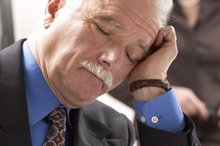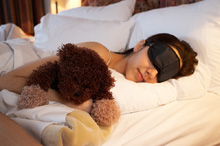Sleep Apnea:
The Silent Killer That Can Raise Your Death Risk 46 Percent
by www.SixWise.com
Some 18 million adult Americans have some degree of sleep apnea, but most haven’t been diagnosed or received treatment, according to statistics from the National Sleep Foundation.
|

People with untreated sleep apnea may face serious sleep problems, including sleep deprivation, sleeplessness and fragmented sleep -- along with a 46 percent increased risk of death!
|
This is concerning considering a recently released study revealed that men between the ages of 40-70 with severe sleep apnea were at twice the risk of dying from a variety of health conditions than men without the disorder, in the same age bracket and in good health. People experiencing mild forms of sleep apnea were not in the same risk category.
What Happens During Sleep Apnea?
Obstructive sleep apnea, one of the most common forms of sleep apnea, occurs when breathing becomes very shallow or stops at intervals during sleeping hours, repeatedly interrupting the sleep cycle.
Apnea means cessation of breath that lasts for at least 10 seconds at a time. When someone has sleep apnea their upper airway collapses during sleep and in cases of severe sleep apnea the patient may experience up to 20 to 30 seconds of a blocked airway before waking up. This cycle can repeat itself sometimes hundreds of time throughout the course of a night. When a sleep apnea episode occurs the diaphragm and chest muscles put forth extra effort in attempts to open the airway and breathing usually begins again with a either a loud gasp, snort or jerking movement of the body.
Who is Most Susceptible to Sleep Apnea?
Sleep apnea affects all ages and both sexes, but there a few specific factors that put people in a higher risk bracket.
Physical Traits Tied to Risk Factors
-
Possible genetic link -- If you are related to someone who has sleep apnea, chances are you are at a higher risk of developing the disorder
-
More prevalent in men than women
-
Higher risk among African-Americans, Hispanics and Pacific Islanders than in Caucasians
-
Increases as you get older
-
Post-menopausal women
-
People with large or thick necks (17 inches or greater in a man, or 16 inches or greater in a woman)
-
People with a large overbite, recessed chin or small jaw
-
People with small airways in their noses, throats or mouths
-
Adults with enlarged uvulas -- the tissue flap that hangs down in the back of the throat, large tongue or soft palate
-
Babies and small children with swollen tonsils
Other lifestyle factors and health conditions that increase the risk include:
-
Obesity
-
High Blood Pressure
-
Heart Failure and Stroke
-
Smoking
-
Alcohol Use
Consequences of Sleep Apnea When Left Untreated
Research shows that most people living with sleep apnea have never been diagnosed or received any form of treatment. One of the biggest indicators of sleep apnea is chronic snoring. Other symptoms may include frequent periods of silence throughout your sleep cycle, choking or gasping during sleep, dry mouth or sore throat upon awakening, headaches in the morning, night sweats and intellectual impairment such as trouble concentrating, forgetfulness or irritability.
When sleep apnea continues without treatment a person can be afflicted with a variety of negative symptoms such as sleep deprivation, sleeplessness, fragmented sleep, depression, irritability, sexual dysfunction, learning and memory difficulties, excessive daytime sleepiness to life-threatening conditions such as heart attack, congestive heart failure and cardiac arrhythmia.
Seven Natural Treatment Options
For mild cases of sleep apnea you can try the following seven self-help techniques:
-
Shed some pounds -- Overweight individuals who drop 10 percent of their body weight can reduce sleep apnea episodes and possibly cure it altogether.
-
Avoid use of alcohol and sleeping pills -- These cause frequent awakenings during the night and makes your airway more prone to collapse during apneic periods.
-
Use pillows that help you sleep on your side -- In some patients sleep apnea occurs when they are sleeping on their back, so using a pillow that promotes sleeping on your side may help.
-
Elevate the head of your bed 4-6 inches. This can alleviate snoring and make breathing easier.
-
Maintain a regular sleep schedule -- Avoid sleep deprivation. To put your mind in a relaxed state and get a restful night’s sleep we highly recommend the Sleep Easy CD.
-
Try using a nasal dilator, breathe right strips or saline nasal spray -- These will help open your air passages and reduce snoring
-
Quit smoking -- This exacerbates the worsening of your airway passages.
|

Support a Healthy Sleep Schedule With the Sleep Easy CD
Sleep Easy CD users have reported:
-
Falling asleep faster
-
Waking up less throughout the night
-
Falling back to sleep faster when awakened during the night
-
Feeling more rested the next morning
37 Minutes Guaranteed to Help You Achieve a Deep Rest
|
If these techniques don’t work you’ll want to seek out your doctor for professional help. Before your doctor visit it’s important to gather the following documents and items: a record of your sleep patterns and the fatigue levels you experience during the day and an updated list of medications you take.
Conventional Treatment Options
If the natural tips above don’t help, your health care provider may recommend one of the following:
The most important thing to remember is to seek help if you suspect you might have sleep apnea. There are many non-invasive treatments that can help you prevent the many risks that untreated sleep apnea poses.
Recommended Reading
17 Tips for Healthy and Peaceful Sleep … Including 6 You May Not Know Of
10 Reasons You May Not be Sleeping Well (and What to Do About It)
Sources
PLoS Medicine August 2009
Helpguide.org
WebMD
National Sleep Foundation
Yahoo! News August 18, 2009